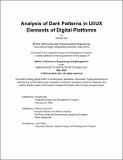Analysis of Dark Patterns in UI/UX Elements of Digital Platforms
Author(s)
Jain, Anukriti
DownloadThesis PDF (2.803Mb)
Advisor
Hu, Antonio (Tony)
Terms of use
Metadata
Show full item recordAbstract
5.35 billion people (the equivalent of 66.2 percent of the world’s population) are using the internet as of January 2024. As the number of users on the internet is growing and the attention span of an internet user has reduced to 8 seconds, one of the challenges that digital businesses face is acquiring, engaging, and retaining users for their products/services. Some companies employ user interface elements on their websites or apps to trick users into signing up or buying a product. Dark patterns are the tricks used by apps and websites that push users into doing things they didn’t intend to, like signing up for a service or making a purchase.
This thesis covers different types of dark patterns, including roach motel, malicious nudging, urgency/scarcity, bait and switch, and confirm-shaming. Dark patterns are also organized into “pressure” and “trickery” categories. Companies leverage dark patterns to meet their business goals, but it is critical to understand the long-term impact of using dark patterns. This thesis explores the possibility of helping users find these patterns and making them vigilant about these dark patterns. These deceptive patterns are common in web flows and are not easily detectable for many people visiting websites. There is a need to build an intervention to create consciousness about dark patterns. This thesis aims to make users aware of dark patterns by building a Chrome extension that will focus users' attention on the information provided and make them aware of dark patterns. First, we will focus on developing a Chrome extension for detecting scarcity/urgency dark patterns.
Date issued
2024-05Department
System Design and Management Program.Publisher
Massachusetts Institute of Technology